Related Research Articles

The Aventine Hill is one of the Seven Hills on which ancient Rome was built. It belongs to Ripa, the twelfth rione, or ward, of Rome. The part of the city that stands on it is sometimes referred to as Reme, or Ream.
The Caelian Hill is one of the famous seven hills of Rome.
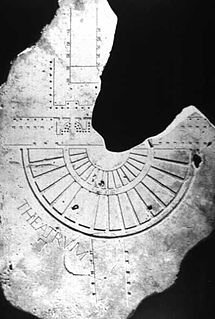
The Forma Urbis Romae or Severan Marble Plan is a massive marble map of ancient Rome, created under the emperor Septimius Severus between 203 and 211. Matteo Cadario gives specific years of 205–208, noting that the map was based on property records.

The Circus Flaminius was a large, circular area in ancient Rome, located in the southern end of the Campus Martius near the Tiber River. It contained a small race-track used for obscure games, and various other buildings and monuments. It was "built", or sectioned off, by Gaius Flaminius in 221 BC. After Augustus divided the city into 14 administrative regions, the Circus Flaminius gave its name to Region IX, which encompassed the Circus and all of the Campus Martius west of the Via Lata.

The Theatre of Pompey was a structure in Ancient Rome built during the latter part of the Roman Republican era by Pompey the Great. Completed in 55 BC, it was the first permanent theatre to be built in Rome.
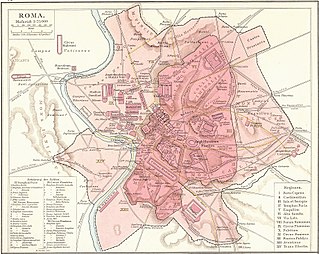
Monte Testaccio is an artificial mound in Rome composed almost entirely of testae, fragments of broken ancient Roman pottery, nearly all discarded amphorae dating from the time of the Roman Empire, some of which were labelled with tituli picti. It is one of the largest spoil heaps found anywhere in the ancient world, covering an area of 20,000 square metres (220,000 sq ft) at its base and with a volume of approximately 580,000 cubic metres (760,000 cu yd), containing the remains of an estimated 53 million amphorae. It has a circumference of nearly a kilometre (0.6 mi) and stands 35 metres (115 ft) high, though it was probably considerably higher in ancient times. It stands a short distance away from the east bank of the River Tiber, near the Horrea Galbae where the state-controlled reserve of olive oil was stored in the late 2nd century AD. The mound later had both religious and military significance.
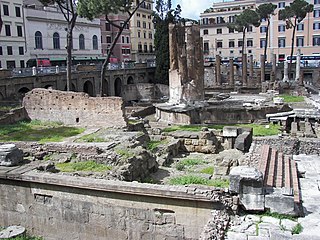
Largo di Torre Argentina is a square in Rome, Italy, with four Roman Republican temples and the remains of Pompey's Theatre. It is in the ancient Campus Martius.

The Milliarium Aureum, also known by the translation Golden Milestone, was a monument, probably of marble or gilded bronze, erected by the Emperor Caesar Augustus near the Temple of Saturn in the central Forum of Ancient Rome. All roads were considered to begin at this monument and all distances in the Roman Empire were measured relative to it. On it perhaps were listed all the major cities in the empire and distances to them, though the monument's precise location and inscription remain matters of debate among historians.
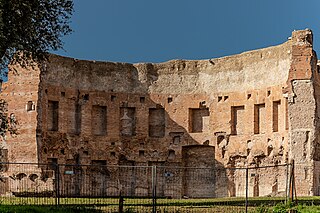
The Baths of Trajan were a massive thermae, a bathing and leisure complex, built in ancient Rome starting from 104 AD and dedicated during the Kalends of July in 109. Commissioned by Emperor Trajan, the complex of baths occupied space on the southern side of the Oppian Hill on the outskirts of what was then the main developed area of the city, although still inside the boundary of the Servian Wall. The architect of the complex is said to be Apollodorus of Damascus. The baths were being utilized mainly as a recreational and social center by Roman citizens, both men and women, as late as the early 5th century. The complex seems to have been deserted soon afterwards as a cemetery dated to the 5th century has been found in front of the northeastern exedra. The baths were thus no longer in use at the time of the siege of Rome by the Ostrogoths in 537; with the destruction of the Roman aqueducts, all thermae were abandoned, as was the whole of the now-waterless Mons Oppius. Early Christian writers misnamed the remains the 'Baths of Domitian'.

The Porta Maggiore, or Porta Prenestina, is one of the eastern gates in the ancient but well-preserved 3rd-century Aurelian Walls of Rome.

The Temple of Antoninus and Faustina is an ancient Roman temple in Rome, which was later converted into a Roman Catholic church, the Chiesa di San Lorenzo in Miranda or simply "San Lorenzo in Miranda". It is located in the Forum Romanum, on the Via Sacra, opposite the Regia.
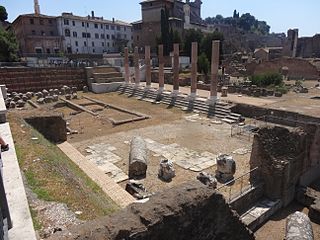
The Temple of Peace, also known as the Forum of Vespasian, was built in Rome in 71 AD under Emperor Vespasian in honour to Pax, the Roman goddess of peace. It faces the Velian Hill, toward the famous Colosseum, and was on the southeast side of the Argiletum.

The temple of Bellona was an ancient Roman temple dedicated to the goddess Bellona and sited next to the Temple of Apollo Sosianus and the Theatre of Marcellus in Rome.
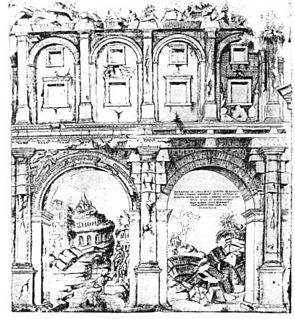
Theatre of Balbus was an ancient Roman structure in the Campus Martius of Rome. It was built in 13 BC by proconsul Lucius Cornelius Balbus (minor), likely from the spoils of a military campaign by order of Augustus.

The Mausoleum of Helena is an ancient building in Rome, Italy, located on the Via Casilina, corresponding to the 3rd mile of the ancient Via Labicana. It was built by the Roman emperor Constantine I between 326 and 330, originally as a tomb for himself, but later assigned to his mother, Helena, who died in 330.

The basilica of Santi Cosma e Damiano is a church in Rome, Italy. The lower portion of the building is accessible through the Roman Forum and incorporates original Roman buildings, but the entrance to the upper level is outside the Forum. The circular building located at the entrance of the Forum, which now houses a small archeological exhibit, was built in the early 4th century as a Roman temple. It is thought to have been dedicated to Valerius Romulus, deified son of the emperor Maxentius. The main building was perhaps the library of an imperial forum.
Aedes Tensarum was a small temple located in area Capitolina on the Capitoline Hill of ancient Rome that is only attested in a military diploma.

The Temple of Claudius, also variously known as the Temple of the Divus Claudius, the Temple of the Divine Claudius, the Temple of the Deified Claudius, or in an abbreviated form as the Claudium, was an ancient structure that covered a large area of the Caelian Hill in Rome, Italy. It housed the Imperial cult of the Emperor Claudius, who was deified after his death in 54 AD.
The Temple of Minerva was a temple on the summit of the Aventine Hill in Rome, next to the Temple of Diana. It is now completely disappeared, but the Forma Urbis Romae confirms its appearance as a peripteral hexastyle on a different orientation to the Temple of Diana.
References
- ↑ L. Richardson, jr (1 October 1992). A New Topographical Dictionary of Ancient Rome . JHU Press. ISBN 978-0-8018-4300-6.
- ↑ "Data". formaurbis.stanford.edu.
- ↑ Emilio Rodríguez Almeida (1981). Forma urbis marmorea: Testo. Quasar. ISBN 978-88-85020-22-1.
| | This article about an Ancient Roman building or structure is a stub. You can help Wikipedia by expanding it. |
| | This article about an Italian building or structure is a stub. You can help Wikipedia by expanding it. |